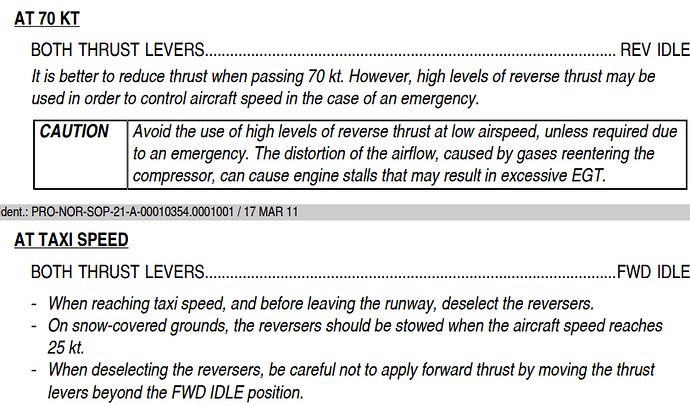To all the simulator pilots and real-life pilots of A320, I would like to ask the following:
- Do you always land your plane manually in good visibility?
- What height AGL do you disengage the autopilot?
- In the A320, or other airbus models (for the real-life pilots), do you also disengage the auto-throttle during manual landing, or do you leave the auto-throttle armed and just set your Vref for whatever flap setting you use to land?
- I don’t know this for a fact with real-life airbus, but does the auto-throttle disengage automatically on touch-down when reverse thrust is engaged?
Thanks in advance!
Elmo A
It is airbus standard operating procedure to have the auto thrust on during approach as it will target approach speed (or selected speed) and reduce crew workload.
The retard call-out is the reminder to manually put the throttles to idle 20ft AGL which will also disconnect the auto thrust.
Followed by reverse thrust unless airport or company procedures don’t allow this then it would normally be reverse idle.
Do you know if putting the thrust levers into reverse idle, just prepares the engines to go into reverse faster, if necessary, or is there some other difference in engine performance, between Idle and Reverse Idle that necessitates this position?
Idle reverse opens the buckets and helps to slow in a more quieter fashion, it also allows you to be ready to use reverse thrust if needed.
Even normal idle on the a320 can provide forward motion so you are trying to stop all forward motion in the most efficient way possible with minimal noise.
However you want to be 100% committed to stopping on the ground once you have selected reverse or reverse idle (off the top of my head this may also be an airbus operating procedure but not 100% sure).
1 Like
- Yes, maximising my interaction and Flight Dynamics fidelity of the add-on
- Depends on the ILS category, usually at around 1,000 feet or whenever established on ILS
- Nope, auto-throttle is always on as much as possible. Real life examples:
Even when approaching Paro (VQPR) in Bhutan, they turn off everything, including GPWS, but not the auto-throttle. It reduces your workload immensely while focusing on maneuvering the aircraft precariously near to mountain cliffs.
- A/T is off when you retard the lever to idle. When you pull back from CL detent, it will only limit the max thrust to the lever position all the way until you hit idle detent.
As for idle reversing:
- saves fuel
- reduce noise
- some aerodynamic brake from the opening clamshell / sliding engine cowling door
But for immediate maximum reversing effort, real life pilot videos show them delaying the retardation all the way to touch down, so the engine stays spooled (you can also see the same from the previous video)
My understanding, from watching streams by (mostly) german speaking real life A320 pilots, is that AT on/off during approach and landing is an airline SOP question.
Apparently the SOP for most german operators (eg. Lufthansa group airlines) is that manual landing should be done with AT off, aka manual flight and manual thrust for proficiency reasons.
I hope someone can confirm.
For me personally I used to always have AT on during landing, but recently I’m trying to get better handling of manual thrust, so I land with manual thrust. Usually hand fly once established.
It’s crazy that Lufthansa do this as it’s against airbus sop
I’m not aware of many instances where the airline will overrule the manufacturers sop
1 - I always land the plane manually, doesn’t matter about the weather, if I can see the runway, I land.
2 - Follow the weather minimums, if MDA is 250ft AGL, and I can see the runway, Autopilot gets disconnected and I land, if I can’t see the runway, its a go-around.
3 - Auto throttle stays engaged (in the A320) until “retard” is announced (about 20ft AGL). I disconnect the auto-throttle on the 737 when the autopilot is disengaged.
4 - UNK (not an Airbus pilot)
Hope you like the flying the A320, its a lovely bird, very easy to handle and manage. I usually only take it out when I feel like a relaxing flight. LOL
Sim pilot here
1.yes always (otherwise wheres the fun?  )
)
2.1500ft
3.armed always
4.Im pretty sure it does otherwise it would be quite dangerous
I also always ignore the retard warning and only go idle when i get the 10ft callout - much easier landings
Interesting point as this is also the retard call out for auto land, I don’t know the reason behind retard being at 10 on auto land and 20 on manual
Why are APU itself and APU bleed switched on in the video during landing in Butan? )
IANAP but I could come up with a couple of guesses.
Given it’s Bhutan and surrounded by high mountains maybe they want to ensure maximum performance is available from the engines in the event of an engine out, or a go around? The bleed air reduces engine performance by a small amount, running the APU bleed means the engine bleed air is not used and maximum performance should be available.
Or maybe they wanted the APU ready on landing.
I think we need a specialist here )
Probably not too many Paro qualified Airbus pilots reading this forum. 
1 Like



